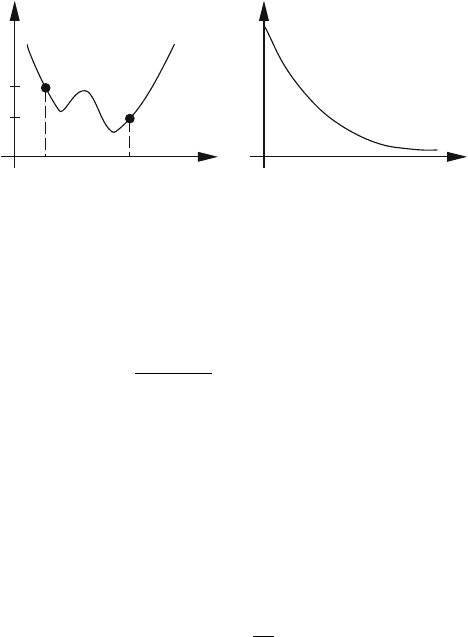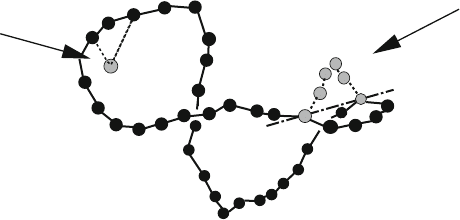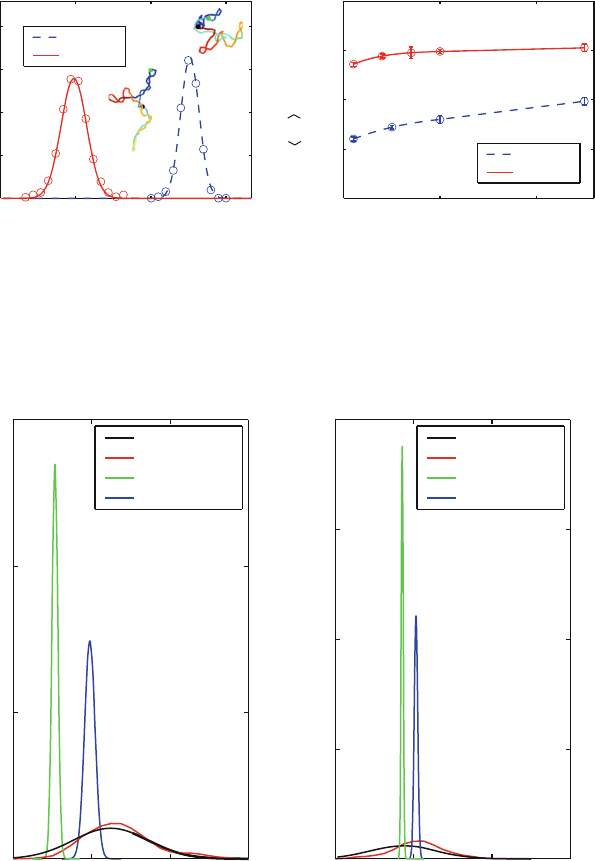Schlick T. Molecular Modeling and Simulation: An Interdisciplinary Guide
Подождите немного. Документ загружается.


410 12. Monte Carlo Techniques
Thus, in reporting an MC average, we say that we have estimated I within one
standard error (i.e., σ/
√
N)of¯y
N
as:
I =¯y
N
± σ
¯y
/
√
N. (12.29)
For example, N =10, 000 yields a result that is at best roughly 1% accurate;
for correlated data, such as from molecular dynamics simulations, a much larger
N is required for that accuracy. Note that this 1/
√
N scaling of errors is a general
feature of MC methods and is independent of the space dimension involved; that
is why MC is frequently the method of choice for multidimensional integrals.
Since we know that the limiting distribution for ¯y
N
is the normal distribution
N, we say that 68.3% of the time this estimate is within one standard error of
I [625]. The above integral estimates can be generalized to independent random
samples from other probability densities, as described in the next section.
Note that the above errors are statistical and can be controlled. The more seri-
ous errors in MC algorithms are the systematic errors, such as discussed above
in connection with random-number-generator artifacts. Both errors should be
monitored to the extent possible.
12.4.3 Batch Means
When the MC data are highly correlated, the error bars may decrease much more
slowly with N as in the above idealized case. The effective number of samples
is then N/τ where τ is the decorrelation time (number of steps) for the data.
This value can be determined by examining auto and cross-correlation functions
for the most slowly-varying properties of the system or by using the method of
batch means. Extensive mathematical/statistical tests for independence are also
available to estimate confidence intervals of independent means [706, Chapter 4].
Essentially, we divide the sample size N into M batches {B
1
,B
2
,...,B
M
}
each of b = N/m elements where M should be significantly greater than τ;we
then obtain a mean over each batch sample:
¯y
B
i
=
1
b
y
i
∈B
i
y
i
,i=1,...,M, (12.30)
and then set the ¯y
N
estimate as the average over all these means:
¯y
M
=
1
M
M
i=1
¯y
B
i
. (12.31)
In reporting the estimator of form (12.29), the relevant sample size (M rather than
N) and variance to is determined from the above mean, that is:
σ
2
¯y
M
=var(¯y
M
)=
1
M
M
i=1
(¯y
B
i
− ¯y
M
)
2
. (12.32)

12.5. Monte Carlo Sampling 411
It can be shown that if the batch size M is sufficiently large, the means of the
batches are approximately uncorrelated. In practice, variations on the basic batch
means method sketched above, and additional tests, are needed to yield good
statistics [706, pages 528–530].
12.5 Monte Carlo Sampling
12.5.1 Density Function
The properties of many molecular systems can be described by a separable
Hamiltonian of general form
H(q, p)=E
k
(p)+E
p
(q)=
1
2
p
T
M
−1
p + E
p
(q) , (12.33)
where E
k
and E
p
are the kinetic and potential energy components, respectively,
and q and p are the collective position and momentum vectors of the system. This
Hamiltonian function forms the basis for MC simulations applied to estimate var-
ious properties of large molecular systems, such as geometric and thermodynamic
functions. However, the MC estimates must emulate a probability density func-
tion ρ(q, t) or ρ(q, p, t) appropriate for the statistical ensemble (t denotes time).
This probability density ρ may or may not be known.
12.5.2 Dynamic and Equilibrium MC: Ergodicity,
Detailed Balance
MC simulations can be used to mimic a dynamic process (ρ depends on time t), as
in Brownian dynamics. They can also generate an ensemble around a statistical
equilibrium, as in some conformational sampling studies.
Dynamic Process
In the former case, a deterministic rule (such as based on Newton’s equations
of motion in the diffusive limit) is used to generate each configuration from the
previous configuration given initial conditions ρ(q, p,t
0
), and that rule determines
the resulting ρ(q, p,t) for t>t
0
.
Below we use the notation X to represent the collective phase-space vector
(q, p); when discussing the Metropolis algorithm later, the momentum component
drops out. (This variable X should not be confused with the random variable X
defined in Box 12.1).
Equilibrium Process
The equilibrium ensemble regime is appropriate when ρ(X, t)=ρ
0
(X) for some
t>t
0
, as in the Metropolis algorithm (see below). The ensemble average is then

412 12. Monte Carlo Techniques
considered as an estimate for the time average, which may be much more complex
to follow. This assumption, though very difficult to prove in practice, is known as
the ergodic hypothesis.
In this statistical equilibrium case, the rule that generates X
n+1
from X
n
need
not have a clear physical interpretation. However, to be useful for sampling, the
rule must ensure that any starting distribution ρ(X, t) should tend to the stationary
density ρ
0
(X) and that the system be ergodic (i.e., as t →∞, the system spends
equal times in equal volumes of phase space); see [547] for a rigorous definition.
When the rule also obeys detailed balance (i.e., moving from state X to Y is as
likely as returning to X from Y ), an equilibrium process is approached (though
biased techniques may violate detailed balance and still approach the right answer
through correcting for violations).
These criteria are crucial for constructing practical sampling algorithms for
physical systems; efficient sampling of configurational space is another important
aspect of computer simulations, especially for large systems where configuration
space cannot be sampled exhaustively.
12.5.3 Statistical Ensembles
Common statistical ensembles used in biomolecular simulations are the canoni-
cal or constant–NVT (N = number of particles, V = volume, T = temperature),
microcanonical or constant–NVE (E = energy), isothermal-isobaric or constant–
NPT (P = pressure), and grand canonical or constant–μVT (μ = chemical
potential) [22].
Canonical Ensemble and Boltzmann Factor
The probability density function for the canonical ensemble is proportional to the
Boltzmann factor:
ρ
NVT
(X) ∝ exp (−βE(X)) , (12.34)
where E is the total energy of the system and β =(1/k
B
T).
(In the Metropolis algorithm, it is sufficient to work with the potential energy,
since the potential energy is independent of momenta; see below).
Hence for two system states X and X
, the corresponding probability ratio is:
ρ
NVT
(X)
ρ
NVT
(X
)
=exp(−βΔE) , (12.35)
where
ΔE = E(X) − E(X
) .
See the sketch of Figure 12.4. The normalizing factor in the proportionality
relation (eq. (12.34)) is the total partition function for all of phase space. That is:
ρ
NVT
(X)=
1
(h
3N
)N!
exp (−βE(X))
Q
NVT
(12.36)

12.5. Monte Carlo Sampling 413
exp(−ΔE/k
B
T)
Δ
E
X
Δ
E
E(X)
X
’
E(X
⬘
)
Figure 12.4. The Boltzmann probabilities for two system states X and X
with energies
E(X) and E(X
) are related at equilibrium by the probability ratio exp [−ΔE/k
B
T].
where h is Planck’s constant, the factor N! accounts for the indistinguishability of
the N particles, and Q
NVT
is the canonical partition function:
Q
NVT
=
1
(h
3N
) N!
exp (−βE(x)) dx , (12.37)
where x is a point in phase space.
The correspondingmeans for the system for a function A can then be written as:
A(x)
NVT
=
ρ
NVT
(x) A(x) dx . (12.38)
The Metropolis algorithm described below is used to generate an appropriate
Markov chain (see below) from which the expected value of A is calculated as:
A(x)
NVT
= lim
M→∞
1
M
M
i=1
(A(x
i
)) . (12.39)
In other words, the density function is already built into the generation algorithm
through an appropriate acceptance probability.
12.5.4 Importance Sampling: Metropolis Algorithm
and Markov Chains
To obtain reliable statistical averages, it is essential to use computer time effi-
ciently to concentrate calculations of the configurational-dependent functions in
regions that make important contributions. This concept is known as importance
sampling.
In many applications, it is possible to focus sampling on the configurational
part of phase space (i.e., E is the potential energy component) since the pro-
jection of the corresponding trajectory on the momentum subspace is essentially
independent from that projection on the coordinate subspace. Hence X below is
the collective position vector only.

414 12. Monte Carlo Techniques
Markov Chain
Metropolis et al. [856] described such an efficient and elegantly simple procedure
for the canonical ensemble. In mathematical terms, we generate a Markov chain
of molecular states {X
1
,X
2
,X
3
,...}constructed to have the limiting distribution
ρ
NVT
(X). In a Markov chain, each state belongs to a finite set of states contained
in the state space D
0
∈D, and the conditional distribution of each state relative
to all the preceding states is equivalent to that conditional distribution relative to
the last state:
P {X
n+1
∈D
0
| X
0
,...,X
n
} = P {X
n+1
∈D
0
| X
n
};
in other words, the outcome X
n+1
depends only on X
n
. The Metropolis algorithm
constructs a transition matrix for the Markov chain that is stochastic and ergodic
so that the limiting distribution for each state X
i
is ρ
i
= ρ
NVT
(X
i
) and thereby
generates a phase space trajectory in the canonical ensemble.
This transition matrix is defined by specifying a transitional probability π
ij
for
X
i
to X
j
so that microscopic reversibility is satisfied:
ρ
i
π
ij
= ρ
j
π
ji
. (12.40)
In other words, the ratio of transitional probabilities depends only on the energy
change between states i and j:
ρ
i
ρ
j
=
π
ji
π
ij
∝ exp (−βΔE
ij
) , (12.41)
where ΔE
ij
= E(X
i
) − E(X
j
). See subsection below on MC Moves with
examples of biased sampling.
Metropolis Algorithm
Briefly, the Metropolis algorithm generates a trial
˜
X
i+1
from X
i
by a system-
appropriate random perturbation (satisfying detailed balance) and accepts that
state if the corresponding energy is lower. If, however, E(
˜
X
i+1
) >E(X
i
),then
the new state is accepted with probability p =exp(−βΔE),whereΔE =
E(
˜
X
i+1
) − E(X
i
) > 0, by comparing p to a uniformly-generated number on
(0,1): if p>ran, accept
˜
X
i+1
,andifp ≥ ran, generate another trial
˜
X
i+1
but
recount X
i
in the Markov chain (see Fig. 12.4).
The result of this procedure is the acceptance probability at step i of:
p
acc, MC
=min[1, exp (−βΔE)]
=min
1,
ρ
NVT
(
˜
X
i+1
)
ρ
NVT
(X
i
)
. (12.42)
In this manner, states with lower energies are always accepted but states with
higher energies have a nonzero probability of acceptance too. Consequently, the
sequence tends to regions of configuration space with low energies, but the system
can always escape to other energy basins.

12.5. Monte Carlo Sampling 415
Simulated Annealing
An extension of the Metropolis algorithm is often employed as a global-
minimization technique known as simulated annealing where the temperature is
lowered as the simulation evolves in an attempt to locate the global energy basin
without getting trapped in local wells.
Simulated annealing can be considered an extension of either MC or molec-
ular/Langevin dynamics. Simulated annealing is often used for refinement of
experimental models (NMR or crystallography) with added nonphysical, con-
straint terms that direct the search to target experimental quantities (e.g.,
interproton distances or crystallography R factors; see [676], for example, for
a review of the application of simulated annealing in such contexts.
Metropolis Algorithm Implementation
The Metropolis algorithm for the canonical ensemble can be implemented with
the potential energy E
p
rather than the total energy when the target measurement
A for MC averaging is velocity independent. This is because the momentum in-
tegral can be factored and canceled. From eq. (12.38) combined with eq. (12.34),
we expand the state variable x to represent both the momentum (p) and position
(q) variables, both over which integration must be performed:
A(x) =
exp [−βE
k
] dp
A(q)exp[−βE
p
] dq
exp [−βE
k
] dp
exp [−βE
p
] dq
=
A(q)exp[−βE
p
] dq
exp [−βE
p
] dq
. (12.43)
The Metropolis algorithm is summarized below.
Metropolis Algorithm (Canonical Ensemble)
For i =0, 1, 2,...,given X
0
:
1. Generate
˜
X
i+1
from X
i
by a perturbation technique that satisfies detailed
balance (i.e., the probability to obtain
˜
X
i+1
from X
i
is identical to that
going to X
i
from
˜
X
i+1
).
2. Compute ΔE = E(
˜
X
i+1
) − E(X
i
).
3. If ΔE ≤ 0 (downhill move), accept X
i+1
: X
i+1
=
˜
X
i+1
;
Else,setp =exp(−βΔE).Then
If p>ran, accept
˜
X
i+1
: X
i+1
=
˜
X
i+1
.
Else, reject
˜
X
i+1
: X
i+1
= X
i
.
4. Continue the i loop.

416 12. Monte Carlo Techniques
rotation
translation
Figure 12.5. Translational and rotational MC moves for a bead model of DNA.
MC Moves
Specifying appropriate MC moves for step 1 is an art by itself. Ideally, this could
be done by perturbing all atoms by independent (symmetric) Gaussian variates
with zero mean and variance σ
2
,whereσ
2
is parameterized to yield a certain
acceptance ratio (e.g., 50%). However, in biomolecular simulations, moving all
atoms is highly inefficient (that is, leads to a large percentage of rejections) [428],
and it has been more common to perturb one or few atoms at each step.
The type of perturbations depends on the system and the energy represen-
tation (e.g., rigid or nonrigid molecules, a biomolecule or pure liquid system,
Cartesian or internal degrees of freedom). The perturbation can be set as trans-
lational, rotational, local, and/or global moves. For example, in the atomistic
CHARMM molecular mechanics and dynamics program, protein moves are pre-
scribed from a list of possibilities including rigid-residue translation/rotation,
single-atom translation, and single or multiple torsional motions.
For MC simulations of a bead/wormlike chain model of long DNA, we use lo-
cal translational moves of one bead at a time combined with a rotational move
of a chain segment [607]; we must also ensure that no move changes the sys-
tem’s topology (e.g., linking number of a closed chain) for simulating the correct
equilibrium ensemble.
Figure 12.5 illustrates such moves for long DNA. Figure 12.6 illustrates cor-
responding MC (versus Brownian dynamics) distributions of the DNA writhing
number (Wr) and the associated mean, as a function of length for two salt envi-
ronments. Figure 12.7 demonstrates how a faulty move (like moving only a subset
of the DNA beads instead of all) can corrupt the probability distributions of Wr
and the radius of gyration (Rg). Not only do we note a corruption of the distribu-
tions when incorrect MC protocols are used, but a large sensitivity to the initial
configuration (sharp distributions around starting configurations).
The rule of thumb usually employed in MC simulations is to aim for a pertur-
bation in Step 1 (e.g., displacement magnitude or the variance σ
2
associated with
the random Gaussian variate) that yields about 50% acceptance. Thus, we seek
to balance too small a perturbation that moves the system in state space slowly

12.5. Monte Carlo Sampling 417
−16 −13 −10 −7
0
0.5
1
1.5
2
0.01M
0.2 M
500 1500 2500
0
0.25
0.5
0.75
1
0.01 M
0.2 M
L
, bp
Wr
P
(Wr)
Wr /ΔLk
Figure 12.6. MC distributions (curves) versus Brownian dynamics data (circles) of the
writhing number (Wr) distribution of supercoiled DNA (left), and mean values of Wr
(normalized by the linking number difference) as a function of the DNA length (right), at
two salt concentrations. The DNA superhelical density is σ = −0.06 in both panels, and
the left panel involves DNA of length 3000 base pairs. Error bars for BD are shown only if
they are larger than the circle symbol.
−1.2 −0.8 −0.4 0
0
10
20
30
Correct MC
Incorrect 1
Incorrect 2
Incorrect 3
2.2 2.6 3 3.4
0
20
40
60
80
Correct MC
Incorrect 1
Incorrect 2
Incorrect 3
Wr
Rg, 10 nm
P (Wr)
P (Rg)
1
1
2
2
3
3
Figure 12.7. DNA writhing number Wr (left) and radius of gyration Rg distributions as
generated by one correct versus three incorrect MC procedures. The incorrect MC proto-
cols allow only a subset of the beads to move: 25 out of 30 (“Incorrect 1”), or 5 out of
30 (“Incorrect 2, 3”); the last two schemes are started from different initial points. The
DNA modeled has 600 base pairs, with superhelical density of σ = −0.04,andtheMC
simulations consist of ten million steps.
418 12. Monte Carlo Techniques
with too large a perturbation that yields high trial-energy configurations, most of
which are rejected. However, the appropriate percentage depends on the applica-
tion and is best determined by experimentation guided by known outcomes of the
statistical means sought. Much smaller acceptance probabilities may be perfectly
adequate for some systems.
12.6 Monte Carlo Applications to Molecular Systems
12.6.1 Ease of Application
The simplicity and general applicability of Monte Carlo approaches has long
been exploited for molecular applications, especially biomolecules, as reviewed
in [129,347,781,1117,1457].
For example, MC methods can easily be applied to force fields with various
constraints, to functions whose derivative routines are not available, or even to
discontinuous potentials, like the square well potential for fluid or colloidal sus-
pensions [155] or lattice and off-lattice protein models (e.g., [226]). MC methods
also allow facile exploration of variable conditions such as the conformational
dependencies on variable side-chain protonation states for proteins in the electro-
statically drivenMC method (EDMC) of Scheraga and co-workers [1051]. EDMC
in combination with different dihedral angle constraints successfully folded a
villin headpiece [1051].
As described above, MC sampling is used to generate a set of conforma-
tions under Boltzmann statistics. Thus, states that decrease the energy are always
accepted and those that increase the energy are accepted with a probability
p =exp(−βΔE) where β =1/k
B
TandΔE is the energy difference between the
internal energy of the new and old configurations (see eq. (12.42)). In this way,
the molecular system can overcome barriers in the vast conformational space and
escape from local minima.
Though in theory a good MC protocol would sample configuration space ex-
haustively, this becomes more difficult and inefficient in practice as the system
size increases. When the cost of evaluating the energy function for large biomolec-
ular systems is also a factor, millions of MC steps (with possibly many rejections)
can become quite expensive. In addition, selecting the appropriate trial move set
and movement magnitudes for a biomolecule without high rejection rates can be
challenging in practice, and requires a thorough tested and implemented protocol.
Thus, many MC variants have been developed to enhance sampling as well as
efficiency.
Simulated annealing (SA), as described in the previous section, is a way to use
MC for the purpose of global optimization. The idea is to lower the effective tem-
perature gradually according to a specified cooling protocol to overcome barriers
in the rugged landscape. SA can be used successfully as an extended form of MC,
as well as structure optimization and molecular, Langevin or Brownian dynamics.
12.6. Monte Carlo Applications to Molecular Systems 419
In fact, the Scheraga group has developed many stochastic global optimization
methods based on MC [1000]. For example, an MC/Minimization (MCM) hybrid
method [760] searches for the global energy minimum of a protein by an iterative
procedure involving generating a large random conformational change followed
by local minimization of the potential energy; this move is accepted or rejected us-
ing the Metropolis criterion. Friesner and coworkers have found this MC method
to perform well in a variety of applications [372].
In this connection, see homework 13 for the deterministic global optimiza-
tion approach based on the diffusion equation as suggested and implemented for
molecular systems by Scheraga and colleagues [997].
Besides such simulated annealing and global optimization methods based on
MC, many MC variants have been developed, such as biased MC, hybrid MC,
and parallel tempering (or REM), as will be outlined below. See [224, 931], for
example, for reviews and performance comparisons of several MC methods for
molecular systems.
12.6.2 Biased MC
Biased MC variants have been devised with trial moves and hence the conforma-
tional deformations designed to move the system to more probable states. The
Rosenbluth, instead of the Metropolis criterion, is therefore used to factor in the
probability (Boltzmann weights) of all trial positions that were skipped in favor
of the biased moves:
p
acc, biased MC
=min[1,W
i+1
/W
i
] (12.44)
where the Rosenbluth factor W is equal to the product of the sum of the
Boltzmann weights of trial positions for each segment i insertion:
W =
N
i=1
n
k=1
exp (−βE
i
k
) . (12.45)
Here, N is the number of chain segments and E
i
k
is the internal energy of the kth
trial move for adjusting the ith segment. That is, in each step one trial move is se-
lected for each segment i with a probability proportional to its Boltzmann weight,
and this process is repeated for all segments until the entire chain is regrown. In
this fashion, additional overhead is required in biased MC simulations to calculate
that probability ratio.
Configurational bias MC (CB-MC) is a biased MC variant that helps “grow”
a molecule toward particular states. Traditional CB-MC “re-grows” a deleted po-
sition of a polymer at the same end in variable orientations (instead of trying out
all neighboring sites randomly). This results in an exponential scaling time with
polymer length to re-grow a self-avoiding lattice chain due to the high proba-
bility of segment overlaps. In certain applications, much more effective variants
